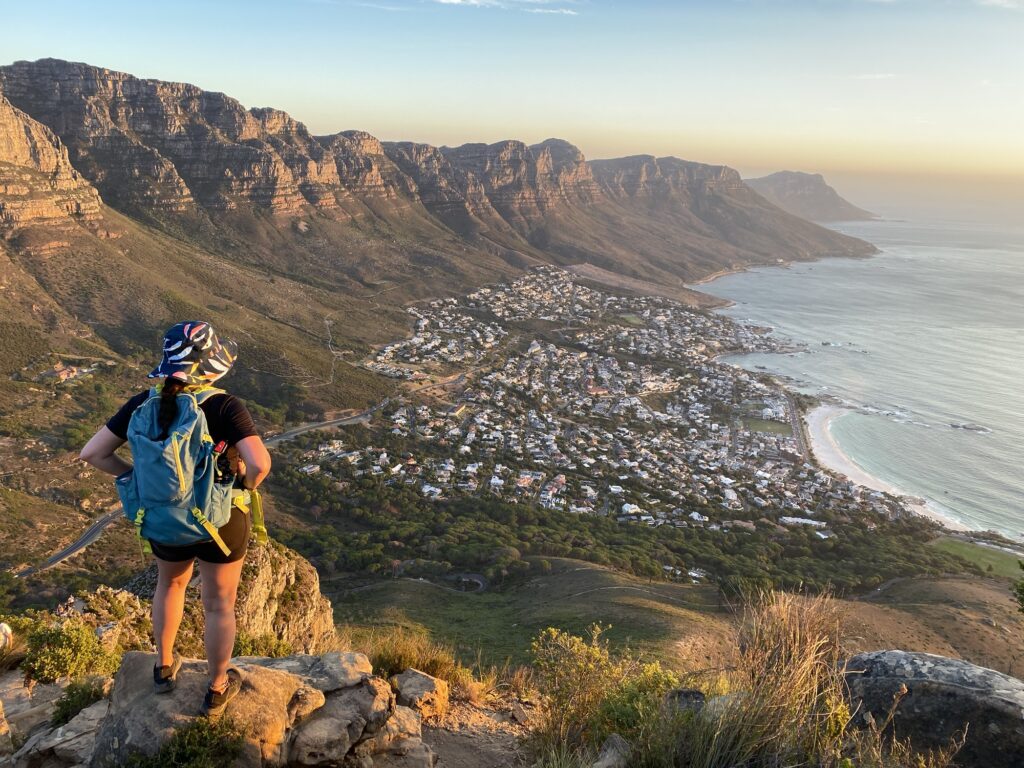
The Basics:
Information correct as of March 2024
Quick Facts:
Currency: South African Rand (ZAR$23.7 = 1 GBP)
Capital: Petoria (Administrative Capital)
Cape Town (Legislative Capital)
Bloemfontein (Juridical Capital)
Population: 59.3 million
Flag carrier airline: South African Airlines
Other airlines: Airlink, FlySafair
Majority Religion: Christian
Official Language: 11 official languages
National Dish: Bobotie
Money: Credit cards and ATMS are widely accepted and available in big towns and cities but it’s advisable to carry cash for transactions in rural areas or smaller establishments especially if you’re purchasing souvenirs from road side vendors.
Language: South Africa has 11 official languages, including English, Afrikaans, Zulu, Xhosa, and Sotho, among others. English is widely spoken and understood, particularly in urban areas, tourist destinations, and business settings.
Climate and Weather: South Africa’s climate varies across regions. In the coastal areas of Cape Town, it has a mild Mediterranean-like climate, while inland regions experience warmer temperatures. With its diverse landscapes, including mountains, savannas, and deserts, the weather conditions can really vary!
Safety and Security: Like many other countries, as a standard, it’s advisable to research travel advisories and staying informed about local events/developments are all things you can do to stay safe. Take necessary precautions and trust your gut to ensure a safe and enjoyable journey. Speaking to the locals to understand which areas should be avoided at night is also a very helpful tool. We took a lot of Ubers around in the evenings/night to avoid wondering around at night.
Researching your trip:
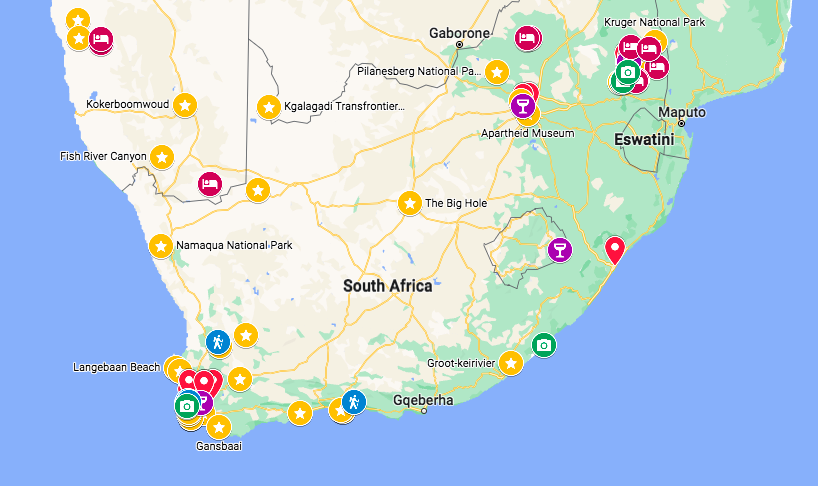
There are a few ways how you could do research for any trip. Everyone has their own method to the madness. Me, I am a visual person so ideally, I prefer to see things on a map… Primarily, where the different points of interest are and how concentrated the points are.
No two maps will ever be identical. You may have your own interests or a different way of categorizing pins. If you would like to build a map like this yourself or research in general, this is how you would do it:
Travel agencies: A classic way to find information about your destination. You can quickly gain inspiration for trail routes from the experts that are frequented by tourists and travellers.
Social Media (Instagram, TikTok, Pinterest etc): leading up to a trip I follow and discover either travellers, locals, tourisms accounts, or content creators and scroll through their feed to find interesting places. I interact with the content and once I find the geotag of an attraction, I pin it on my map. By concentrating my focus to my intended destination, I let the algorithm know that is my current interest and more suggestions pop up on my discovery feed.
Blogs: Discover how other people did it, their opinions on it, what’s recommended, the local nuances, and how to get around. This is also a great way to find places that are “off the beaten track” or haven’t gotten as much traction as some other places.
Books, publications and tv shows: Before heading somewhere, it is almost tradition for me to watch an episode of Anthony Bourdain’s No Reservations or Parts Unknown of the place I’m visiting. It helps give me a sense of what sort of food to expect or local dishes that I should give a go. Also don’t knock off travel magazines or other publications as means of inspiration.
Planning your trip:
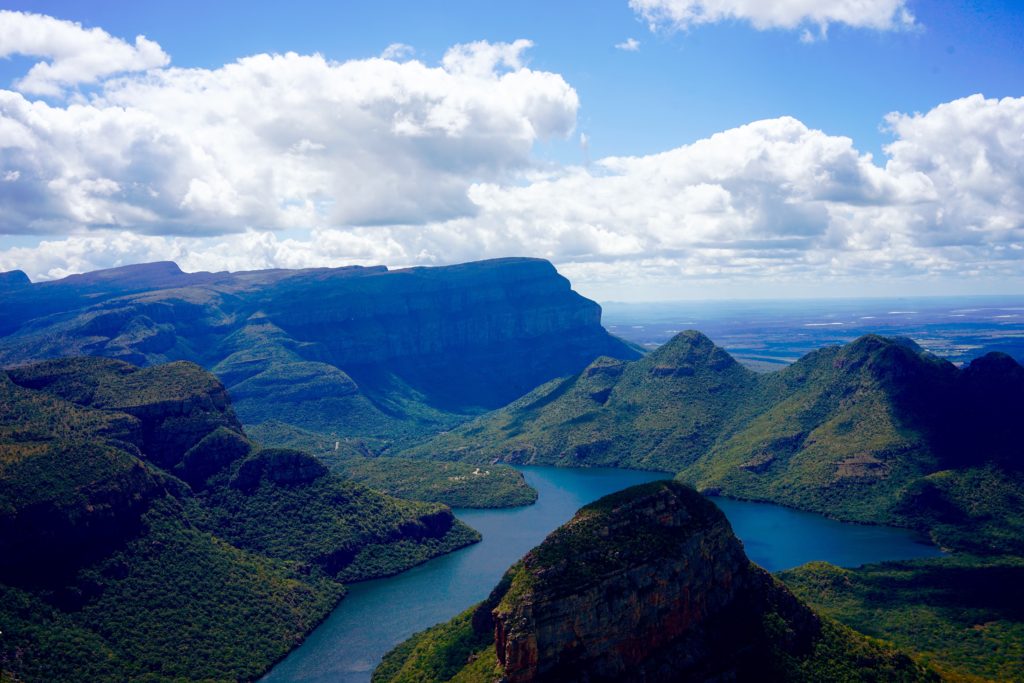
Now onto the nitty-gritty. Putting everything we researched into action – booking flights, accommodation and sorting out the plan.
As my partner and I both work full time, we only had a limited amount of days we could take. Our time frame was 10 working days off (~15 days including weekends). There are several additional places we wanted to visit in South Africa – more of the Western Cape, other national parks, the Garden Route and the eastern surf towns. However, due to the time constraint, we narrowed it down to Cape Town and Kruger National Park. Also, thanks to research, we also saw that we could add the Panorama Route to our itinerary.
But how does it all fit in? Well – since we were planning on doing a safari, we needed to check the prices of doing one and how many days we could afford to. We did extensive research weighing the options between DIY Kruger National Park Safari via car rental and cheaper accommodations, or safari lodges, or cheaper accommodation with additions of game drives. As my partner had been on safaris previously, we thought it would be better for him to experience something different, which was staying at safari lodges. You will read further down how we decided which safari lodge to pick and the deciding factors for this activity.
SO the biggest cost factor, activities-wise, had already been decided, next it was playing around with how we could make this trip efficient with minimal transit times. The next step would be organizing our international and domestic flights.
Getting In
There are two main hubs for international flights, especially from Europe – Cape Town (CPT) and Johannesburg (JNB). How our overall itinerary would flow depended on the price of flights. Unfortunately, as my partner lives in the UK and I live in Norway, that added another layer of complication but seeing as flying from Norway tends to be more expensive, my flight pattern would take precedence.
There were four obvious options for how we could book flights into South Africa:
- Fly in and out of CPT. Take an internal flight to Kruger – however, this would mean we lose days travelling
- Fly in and out of JNB. Take internal flights between CPT – we will spend more money on internal flights
- Fly into CPT and out of JNB – potential
- Fly into JNB and out CPT – potential
Since I am an engineer and my partner is an accountant, we love a good spreadsheet so to decide between the potential options, we listed the travel paths in excel and since we had definite dates, we could easily compare.
We decided with flying into CPT and out of JNB, while the flights were slightly more than flying in and out of JNB. However, we would save money on domestic flights/car rental options. Overall, we would save on transport.
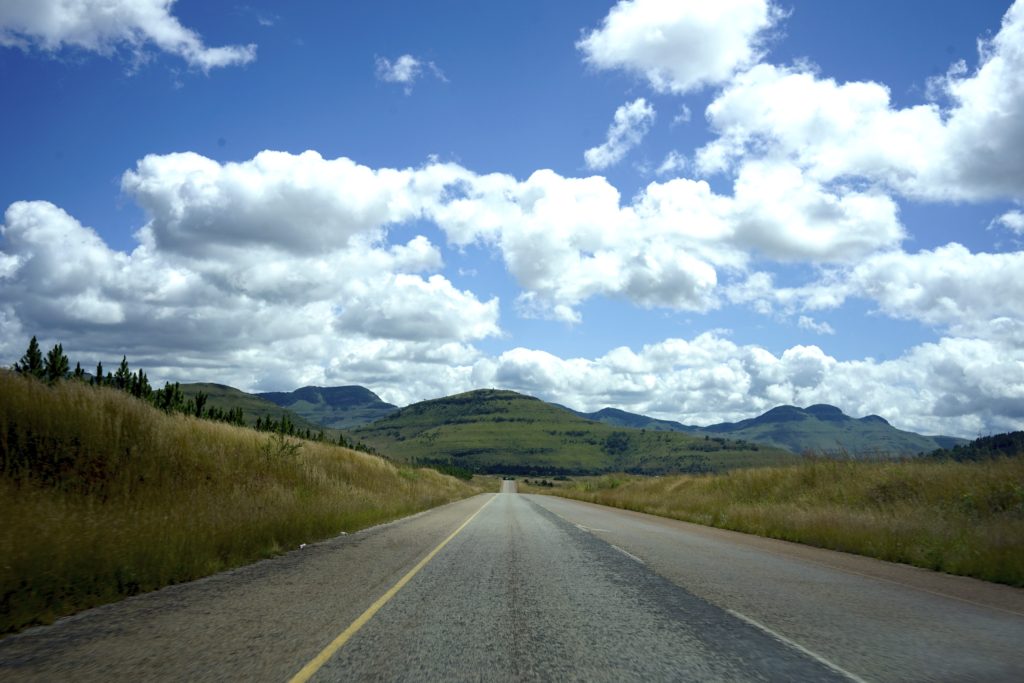
Getting around – domestically
As mentioned with getting into South Africa, we had to decide how to efficiently visit places that were on our list. Driving vs. Internal flights or a combination? We put it all into an excel format and decided to do a combination.

From our excel, it was clear that the cheapest way to see as much as we wanted was to fly from CPT to JNB, rent a car from JNB Airport and drive to the Safari Lodges and lastly fly out of HDS to JNB.
Tip: Safari lodges may offer an additional airport pick up from HDS but at a quite high fee. For some places, this fee was higher than renting a car and dropping it off at a different location so the decision started to be pretty clear for us. If you are interested in visiting the Panorama Route, have a look to see if a one-way car rental would be a cheaper alternative that airport pick up.
Internal flight carriers:
This is a list of internal flight carriers that I found during my research. Before booking flights, compare which flights – timings/pricing/inclusions makes sense for you. I love putting it into an excel sheet to visually see the comparisons.
Airlink – This is who we decided to fly with. The flight timings made the most sense for us and you could get flights between CPT and HDS and HDS to JNB. My primary reason for going with Airlink was that luggage was included in our ticket and you could book multi-city flights as one booking.
South African – The Flag Carrier of South Africa. I personally didn’t see too many domestic flight options between CPT and HDS for our dates.
FlySafair – There were no flights available to HDS, however, there were options to other airports located near Kruger National Park.
Mango – As of 2024, it is under business rescue so I will not elaborate on this.
Car Rentals:
There are a few options, however, we went with one of the international car rental companies as while booking accommodation, we got a really good deal (it was cheaper than booking it independently) and went for it. We booked our rental from Avis.
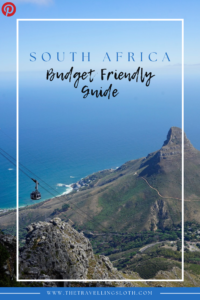
Safaris:
Holy mamma, there are so many different ways plan and do a safari. My only conception of safaris were that they were expensive. However, researching for this trip, the prices definitely can range – from DIY options, simple tenting lodges to the bougiest lodges. There’s something for everyone with varying budgets. Our budget was skewed towards the budget to mid range but we knew that we wanted to experience a few different types of safari accommodation styles and split our allocated time at two different places in Kruger.
Tour:
This was by far the biggest single thing to budget for in our trip. We wanted to see different areas of the famous Kruger National Park and opted to see the Greater Kruger National Park. The only difference between the “actual” Kruger and Greater Kruger is that the reserves surrounding the Kruger are a collection of privately owned land. The animals are allowed to roam between Kruger and Greater Kruger freely. By opting for lodges in Greater Kruger, you would be having your game drives on the lodge reserves rather than in the National Park.
If you want to visit Kruger National Park instead of Greater Kruger, keep in mind that there are only a handful of lodges and rest camps located inside the national park and they tend to be pricy. The other alternatives would be to stay just outside of the park gates and take a game drive tour into the park.
Lodges:
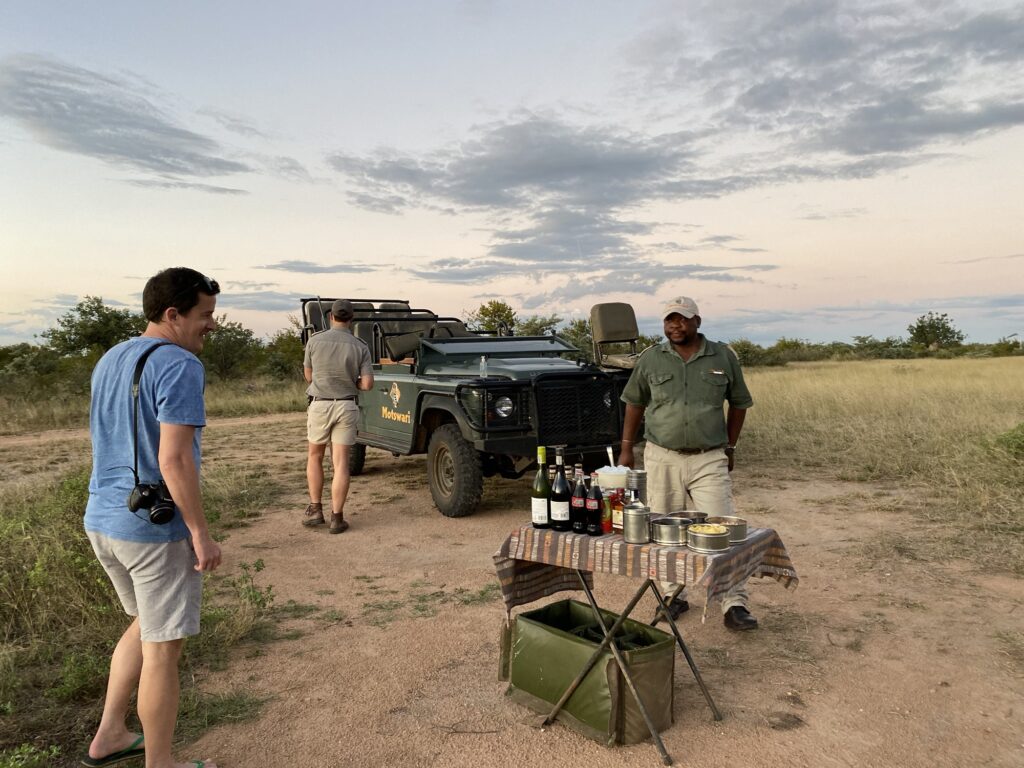
Motswari Reserve: This was such a lovely way to experience my first safari. The property sits in the Timbavati Private Reserve in Greater Kruger National Park. Each guest gets a private hut to stay in and their hospitality was absolutely amazing. Meals and game drives are included in the price. From the entry gates of Timbavati, it takes approximately 45mins to arrive at the property. Straight out the gate, you can start spotting animals.
During the day, the Motswari staff held talks – the one we attended was about the rhinos and it was a fantastic discussion about how education plays a vital part in educating locals and foreigners about conservation. It also gave us a chance to understand why poaching is still ongoing and why some may risk their lives by participating in these illegal activities and what may be the best way forward to protect the rhinos.
There was also a pool on the property to cool down in overlooking a watering hole so your safari never truly ends even when you’re not on a game drive! The Motswari staff are some of the friendliest. Before the meals, they performed a local dance to give thanks to the food and would alternate between having dinner on the grass near the viewing deck or BBQ-styled dinner in one of the many places. As there are no fences surrounding the lodge, at night, guests are required to be escorted back to their huts by a member of staff because you never know what may be nearby! We didn’t see any animals entering the lodge grounds while we were there.
If you’re going on a safari for the first time or even wanting to experience a beautiful lodge, I highly recommend Motswari for such a unique experience.
Tented Lodges:

Bundox Explorer Camp: A completely different experience to Motswari! This property sits in the Olifants Private Reserve and the accommodations are more back to basics. There are 4 permanent tents, equipped with electricity. So this lodge is a lot more intimate. The entire camp runs off the grid utilizing water catchers and solar panel to supply electrician. Even the showers are bush-styled showers with hot-water-on-demand but with running cold water at all times. The property definitely prides itself on its sustainability. A unique thing about this property is the Hide Out where guests can sit in for a couple of hours in the afternoons and observe life around one of the watering hole. An absolute dream!
There is a farm styled pool with a viewing deck overlooking one of the watering holes in front of the property. We spotted elephants while we were cooling down in the pool! It was such an amazing experience. On the viewing deck, the alcohol service is based on a trust system with you writing down how much beers or spirits you’ve taken. There was so many amazing micro experiences we had here. Amazingly, we were the only people staying at the camp! Apart from the staff, of course. So all our game drives, meals and overall experience was essentially private. One of the mornings, the chef made an amazing spread and set up by the river for us, overlooking the hippos in the river.
I would personally recommend Bundox Explorer Camp if you’re looking for a back to basics, sustainable and unique safari experience.
Camping:
There’s a couple of ways of camping in Kruger Nat’l park. All of the tented tours that we saw departed from Johannesburg instead of Hoedspruit. If you’ve got the equipment/4wd camper, you’ll be able to find Rest Camps in Kruger with basic facilities to stay over night in.
Let’s go to South Africa!
I will be writing a more in-depth post about the details of what we did in South Africa in another post so keep your eyes peel for that! However, this was our general outline for our trip.
Day 1 – 5: Cape Town
Day 6: Wine Region
Day 7: Fly from CPT to Johannesburg. Rent another car and start driving to Graskop.
Day 8: Panorama Route and reach the Safari Lodge
Day 9 – 12: Safari (Motswari and Bundow)
Day 13: Fly from Hoedspruit to Johannesburg.
Day 14: Johannesburg and Flying home.
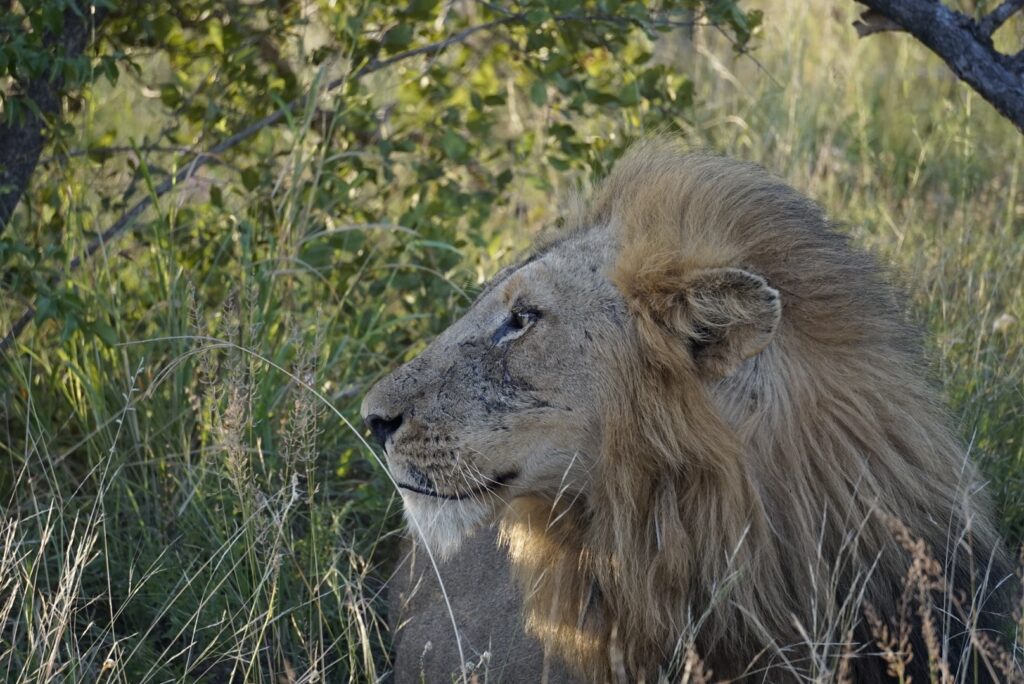
Budget Breadkdown
Embarking on this remarkable journey through Cape Town, Franschhoek, and a thrilling safari in Greater Kruger National Park, we managed to strike a balance between adventure and budget. While not the thriftiest escapade, our spending remained reasonable, affording us the freedom to tailor the trip to our desires. Let’s delve into the specifics:
Cape Town/Franschhoek
- Bike Rental for V&A to Camps Bay Excursion: 295ZAR for half day rental ~£12 per person
- Estimated Daily Food and Drinks: ±800 ZAR (on the mid-level range) ~£35 per person but you can easily go a lot lower and also depending how much you drink.
- Beers were approximately 45-50 ZAR ~£1.20 – £2 per beer.
Safari – 8 game drives – 5 days/4 nights
Motswari Lodge Break Down
Cost: £465 for 2 people for 2 nights
£117 per person per day, inclusive of a dawn and dusk Game Drive, Full board (breakfast, lunch and dinner), drinks during meals, accommodation which was in the style of a modern “hut”, and an unforgettable experience.
Bundox Safari break down
Cost: £530 for 2 people for 2 nights
£132.50 per person per day, covering 2 x Game Drives, Full Board, all non-alcoholic drinks, and accommodation. A slightly higher cost, but as we were here during the weekday, we were so lucky that there was no one else around and it was just us. If you think about it, we essentially had a private safari!
Transport – flights and car rental
- Round-trip Flights (Europe to CPT and JNB back): ca. £500 each
- Car Rental for Exploring Cape Peninsula and Wine Region: £288 for the car.
- Internal Flights (CPT to JNB and HDS to JNB): £288 for 2 people
- Car Rental (JNB to HDS for 6 days): £250 for the car
Accommodation
As mentioned above, our safari packages included accommodations. However, we did stay over in a couple of cities/towns throughout our trip. Respectively the cost of accommodations was:
- Cape Town: £320 (6 nights)
- Franschhoek: £75
- Graskrop: £50
- Johannesburg: £80
Grand Total:
Breakdown:
- International flight: £500 per person
- Safari + Accommodation: £995 Total
- All other accommodation: £525 Total
- Internal Flights: £288 Total
- Car Rental: £538 Total
Please note that this total excludes costs for food, drinks, and other general activities not part of the Safari package as all these would depend on where you eat/visit.
In the end:
Total Cost for the trip (excluding international flights – because this depends where you would be flying from) was – drum roll please: £2345 for both of us or £1173 per person. To break it down even further, £83.70 per day. While this is definitely not the cheapest holiday, we did manage to make it quite affordable between the two of us and have an unforgettable adventure in South Africa.

Of course, this may not be the cheapest holiday or even the most budget way to visit South Africa but it is quite an affordable option to kick off your South African adventures. I was always under the impression that travelling in South Africa would be expensive but with the right research and planning, you can definitely find other alternatives and making it your own.

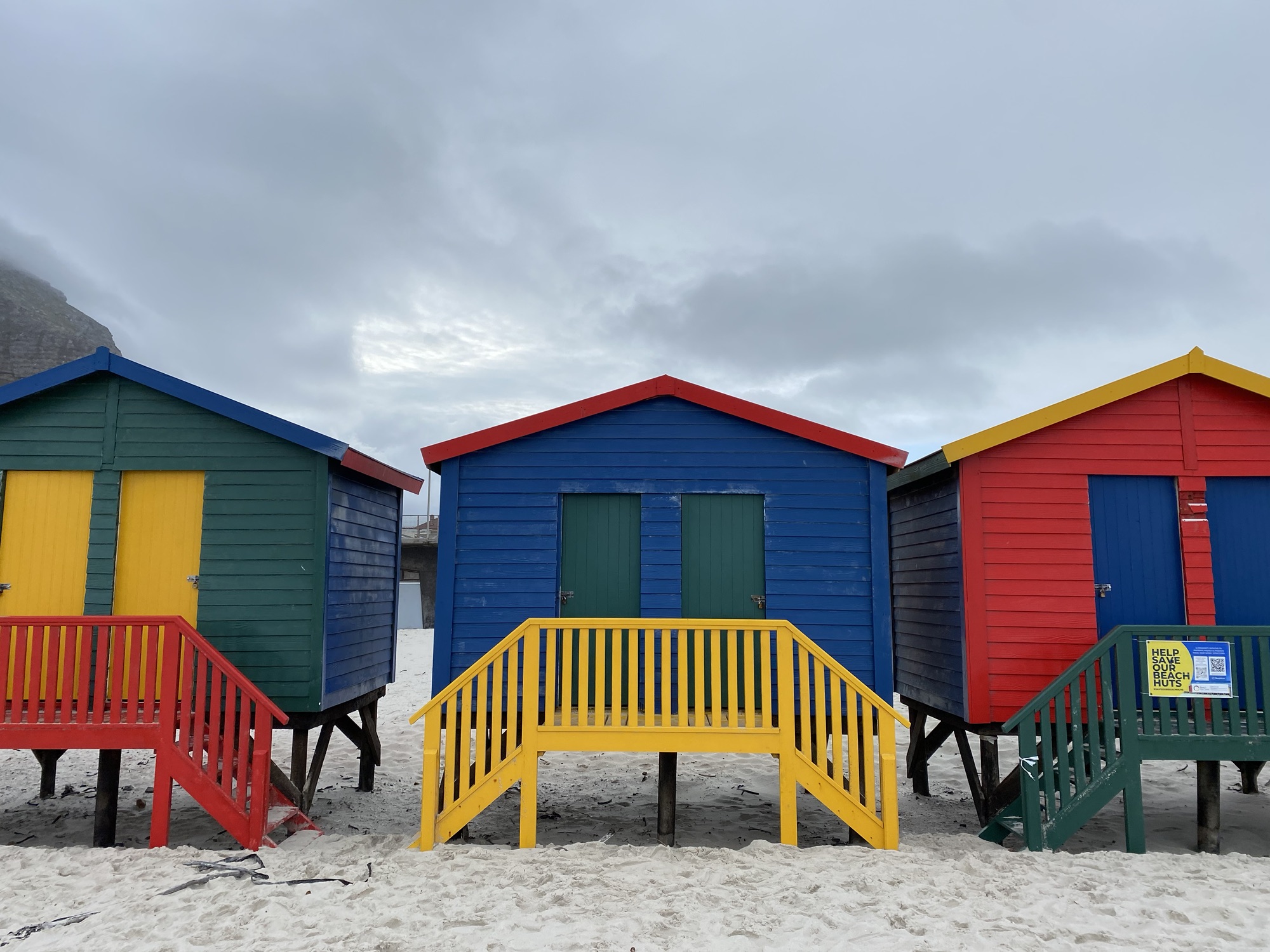
Leave a Reply